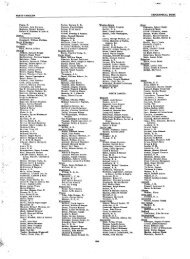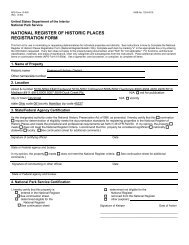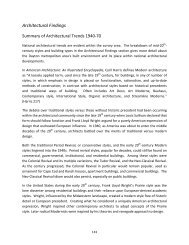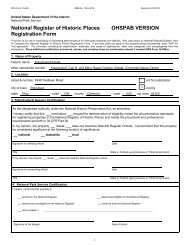National Register of Historic Places Registration Form
National Register of Historic Places Registration Form
National Register of Historic Places Registration Form
Create successful ePaper yourself
Turn your PDF publications into a flip-book with our unique Google optimized e-Paper software.
Southington Local School District Campus<br />
Name <strong>of</strong> Property<br />
Trumbull County<br />
Ohio<br />
County and State<br />
Bloomfield; 1914, and Mesopotamia in 1923. A survey completed in 1981 <strong>of</strong> Trumbull County by the Trumbull<br />
County Planning Commission notes seven school buildings constructed 1906-1936, including Southington’s. Of<br />
those seven, one is extant, in addition to Southington; Mesopotamia’s school, heavily altered, is now used as an<br />
elementary building for the consolidated Mespo-Bloomfield school district. The development <strong>of</strong> neighboring<br />
Farmington Township’s educational system was atypical <strong>of</strong> rural townships in the county due to the early<br />
creation <strong>of</strong> the Farmington Normal School which became the Western Reserve Seminary in 1854. Farmington<br />
did construct a distinguished Neo-Colonial high school building ca. 1920, which was vacated when Farmington<br />
and Bristolville Township school districts merged and it now sits empty. Due to its proximity to Warren, and<br />
city utilities, Champion Township developed a substantial commercial base early and mid twentieth century,<br />
with accompanying residential growth. In 1965, Champion built a modern new high school and converted its<br />
historic (ca. 1915) high school to use as junior high and elementary facility.<br />
As a result <strong>of</strong> the consolidation <strong>of</strong> rural township school districts and new school facility construction within<br />
Trumbull County, Southington Township’s centralized school campus is the last one to still be used for its<br />
original use, and as illustrated above, most <strong>of</strong> the rural public high school buildings constructed during this<br />
period within the Trumbull County have been demolished or abandoned.<br />
The centralization <strong>of</strong> Southington’s school system was not only early compared to much <strong>of</strong> the rest <strong>of</strong> the<br />
county, but was also unique in that it was in part privately funded and resulted in a rare example <strong>of</strong> a privately<br />
endowed public high school in Ohio. Much like the rest <strong>of</strong> the state, the idea <strong>of</strong> centralization was controversial<br />
in Southington when it was first raised in 1903. Citizens were concerned about the potential loss <strong>of</strong> the control<br />
<strong>of</strong> local tax revenue as well as the issue <strong>of</strong> transporting their children outside their own immediate<br />
neighborhood. The question appeared on the Township ballot in that year and was soundly defeated. The issue<br />
was revisited in Southington in 1905 when township native, Newton Chalker (1842-1934) proposed to the<br />
township on September 14 th that he would build and donate a sophisticated, modern high school for the<br />
community, if the community would agree to centralize the school system and provide an elementary building.<br />
The high school building that he proposed and eventually built would also contain a fully stocked public<br />
library, community meeting room and auditorium. On October 10, 1905 a second vote within the community<br />
was held and this time the issue passed by a vote <strong>of</strong> 122 to 34. 6<br />
According to his unpublished autobiography, Chalker was born in Southington in 1842. He obtained his<br />
primary education within the township and, beginning in 1856, attended the Western Reserve Seminary 7 at<br />
West Farmington, five miles north <strong>of</strong> Southington, earning his board there as a laborer. His education would be<br />
interrupted by a lack <strong>of</strong> funds and family obligations until 1862 when he finally completed his secondary<br />
education in Farmington. At that time he enlisted in the Ohio Volunteer Infantry to serve in the Civil War. He<br />
trained at Camp Chase near Columbus and was sent to Harper’s Ferry early in July, 1862 where he joined about<br />
ten thousand other Union soldiers to protect the Potomac River crossing located there. In September, an attack<br />
by General Thomas (Stonewall) Jackson resulted in his being taken prisoner and held until the end <strong>of</strong> the war<br />
when he was released and returned home to Southington. After his military duty, Chalker studied law until<br />
1868, finally establishing a law practice in Akron in 1869. In addition to his law practice, Chalker was also<br />
involved in real estate development in Akron, subdividing a twenty one acre tract land acquisition into<br />
residential lots in the ‘North Hill’ area. 8 In 1893, at the age <strong>of</strong> 51, Chalker retired and devoted his time to travel<br />
6 A Son <strong>of</strong> Southington Offers to give Large Sum for the Erection <strong>of</strong> a High School, Warren Daily Tribune, 11 October 1905, p.1.<br />
7 The Western Reserve Seminary was known as the Farmington Normal School until taken over by the Erie Conference <strong>of</strong> the<br />
Methodist Episcopal Church in 1854. The last commencement took place in 1906. None <strong>of</strong> the associated buildings are<br />
extant.<br />
8<br />
Harriet Taylor Upton, A twentieth century history <strong>of</strong> Trumbull County, Ohio, Volume I1,( Lewis Publishing Co. 1909), p. 424.<br />
12






